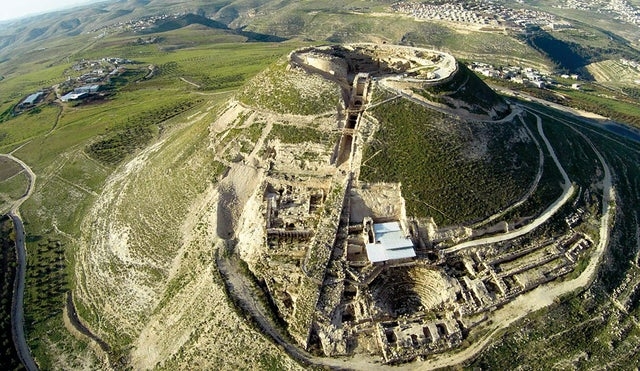On May 8th, 2007, the Israeli Antiquities Authority revealed that the tomb of King Herod the Great was found at Herodium in the Judean Desert in an excavation led by archaeologist Ehud Netzer from the Hebrew University of Jerusalem.
Among the artifacts found along with the tomb was a podium and some urns and a limestone sarcophagus decorated with rosettes. The sarcophagus is broken into hundreds of pieces. This destruction of Herod’s remains is thought to have been carried out during the Great Jewish Revolt against Rome between 66 and 73 AD. either by Jewish rebellion troops or Roman soldiers, a sign of the complicated legacy of Herod.
27 April 2007. Israeli archaeologists discovered the tomb of “Herod the Great”, the ancient Roman client King of Judea. Herod was the King of Judea from 37 BC to 4 AD and in power at the time of the birth of Jesus Christ. The new discovery was publicly announced on 8 May 2007. pic.twitter.com/kkA2jvJPOL
— Prof. Frank McDonough (@FXMC1957) April 27, 2023
Born in 73 BC Herod conquered Jerusalem in 37 BC with the help of Rome and became the Jewish king of Judea as a puppet ruler for the Roman Empire. Herod expanded the war-torn Judean territory and wealth significantly, through the constriction of new cities and fortresses across his kingdom.
Perhaps Herod’s greatest achievement in the eyes of the Jewish people is the ‘facelift’ he designed for the decaying Second Temple. His architectural brilliant plan expanded and upgraded the Second Temple in Jerusalem, including erecting a platform to flatten the Temple Mount, with the foundation remaining until today in the form of the Western Wall. Herod was a political, military, and architectural genius but also was known for cruelty and debauchery and had a number of members of his own family executed.
'In my opinion, the discovery of Herod's tomb at Herodium by Ehud Netzur is the most important discovery in the region since the Dead Sea Scrolls'
— Ancient History Hit (@AncientsHH) April 25, 2023
King Herod - with Dr Jodi Magness 🎧 https://t.co/oQdMEp2cYd pic.twitter.com/hWO0dh3AqP
Ehud Netzer, who learned about Herodian architecture while working on Yigael Yadin’s excavations at Masada, started digging at Herodium in 1972 and began searching for Herod’s tomb by 1977. It has always been known from the ancient historian Josephus that Herod was buried at Herodium, his desert retreat and architectural masterpiece, but the exact location along the vast mountainside was unknown. The digging also required much studying and the preservation of Byzantine ruins before reaching the Herodian site.
The entire Herodion complex was given a few peculiar names over the years by different settlers of the land. According to the Arabs, the place is called “Jebel Poridis” since the name Poridis is a late incarnation of the name Herodis, and hence this name commemorates the builder of the mountain Herod. Some Crusaders called the mountain “Frankenberg", following a tradition from the 15th century that claims that after the defeat of the Crusaders in Jerusalem, the fugitives fled to Herodion and fortified themselves there for 40 years.


